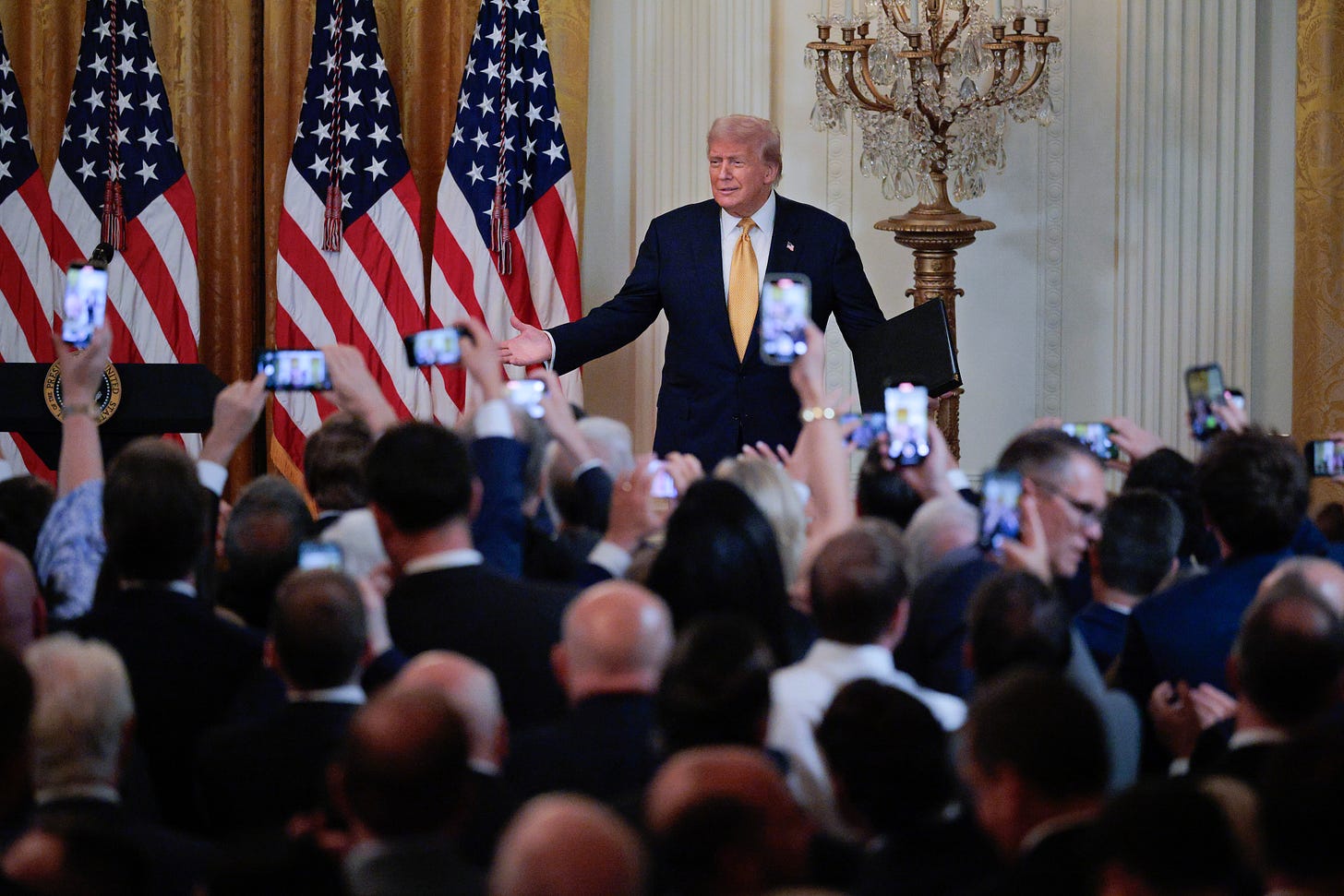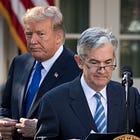Rules Matter More Than Rulers
A thought experiment for a post-Trump America.

Imagine you’re a contestant on a new gameshow. Let’s call it “The Future of American Democracy.” The lights dim. A booming voice announces the stakes. You, the voter, must choose between two sealed doors. Behind each lies a prospective future. There is no third door. Pick wisely.
Door #1: A Democrat occupies the Oval Office, committed to reversing the Trump Administration’s legacy. Given the expansion of executive power in recent years, the new president’s authority is largely unconstrained. The excesses of DOGE, for example, are reversed on Day One. Civil servants are reinstated. Funding for environmental protections, universities, and public broadcasting is restored. More than that, through the power of executive orders, new programs dedicated to addressing social justice issues—from housing and healthcare to universal basic income—are created with a stroke of a pen. Congress, reading the political mood, falls in line and defers to the president’s will.
Door #2: A MAGA-aligned figure sits in the White House, eager to extend Trump’s protectionist policies and anti-immigrant, culture war agenda. But rather than enjoying expanded executive powers, the president is hemmed in by institutional guardrails. The Supreme Court is laser focused on ensuring that the rule of law prevails over executive whim. It maintains fidelity to constitutional principles such as civil liberties and the separation of powers. And Congress has reasserted its constitutional prerogatives to legislate, to control the power of the purse, and, perhaps most importantly, to oversee the executive. It guards that authority jealously.
If you flinched at Door #2, you’re not alone. When I propose this mental experiment, many of my more progressive friends recoil at the idea of a second Trumpian presidency, or anything that even rhymes with it, and you might too. But take a breath. Set aside, just for a moment, the personalities and the policies. Ask a deeper question: in which world does a democracy better survive?
The right answer, the responsible answer, is Door #2. And the reason is painfully simple: in a republic worth preserving, rules matter more than rulers.
This argument is not an easy sell. For many Americans, particularly on the left, the priority feels obvious: keep Trump and his acolytes as far from power as possible. That instinct is understandable. The president’s open contempt for democratic norms, assaults on the rule of law, and ongoing attempt to erect an authoritarian system of government all cry out for repudiation. Who wouldn’t want a government committed to undoing the damage?
But here’s the problem: in our zeal to empower the right people, we risk breaking the very institutions meant to outlast them. If democracy becomes a tool to be wielded by those with the right intentions, then it becomes something else entirely: a vehicle for righteous domination.
When we justify expanding executive power because we trust the person in office, we forget that tools built for our friends will soon be wielded by our adversaries. The same broad authorities used to protect liberal democracy can just as easily be turned against it.
We already live with the legacy of this short-sighted logic. Consider the emergency powers accumulated across administrations of both parties. Once justified by noble ends—wars waged against Nazis and terrorism, for example, or interventions aimed at saving American industry—those powers have become enduring features of a presidency that increasingly resembles a throne.
Consider, for example, the National Emergencies Act of 1976, which created a process by which presidents can declare an emergency and unlock sweeping statutory powers—over 130 discrete authorities to redirect funds, impose sanctions, or deploy troops. The Act incentivizes a perpetual state of emergency, with 48 national emergencies currently in operation across the country. Or consider the Defense Production Act of 1950. Born in a time of war, the Act is now routinely invoked, from COVID-era ventilator mandates to clean energy production orders. Each use deepens the norm that presidents may reallocate private sector priorities in non-wartime situations. Or consider the Authorization for Use of Military Force (AUMF), passed in 2001 to fight al-Qaeda, which has since been stretched to justify drone strikes and military actions across multiple countries never named in the original authorization, against actors never foreseen—effectively giving successive presidents expansive global war-making latitude.
If we really care about liberal democracy as such, and not just its outcomes when our side wins, we need to design a system that works even when our opponents are in charge. That means restoring and reinforcing constraints on power at the level of constitutional and institutional design. Constraints such as a Congress that doesn’t act like a presidential advisory board, but as a coequal branch. Courts that enforce limits on executive power, even when it’s politically inconvenient. A public culture that prizes constitutional process over partisan victory.
In this vision, Door #2 becomes a grim but necessary choice. Not because we admire the illiberal moves of the MAGA right or trust one of its acolytes not to double down. Far from it. But because the best way to prepare for bad rulers is not to pray for good ones. It’s to build a system strong enough to contain the bad.
The framers of the Constitution knew this. They designed a government of ambition counteracting ambition. They understood that human virtue could not be assumed, and so they hedged against its absence. A democracy that survives only in the hands of angels is not a democracy—it’s wishful thinking.
There is a progressive case for Door #1. It goes something like this: the stakes are too high, the crises too urgent. Climate change, democratic erosion, political and economic inequality—we can’t afford procedural niceties. We need decisive action, and that requires executive muscle.
But that logic, though seductive, is dangerous. It treats institutional constraints as mere obstacles to justice, rather than as the scaffolding of a free society. It assumes that power wielded by the virtuous will remain virtuous. It doesn’t.
Take the recent calls for expanding the Supreme Court or abolishing the filibuster. These may be understandable reactions to conservative judicial dominance or legislative gridlock. But they are also signs of a deeper impatience with the slow, frustrating work of democratic compromise.
Of course, many who favor Door #1 wouldn’t if the names were reversed. In fact, we’re seeing what that would look like right now. As Trump deploys emergency powers to bestow favors upon friendly corporate interests, the left calls it out as cronyism. When Trump gets the most basic lessons of international trade exactly wrong, they expertly articulate the benefits of a stable, low-tariff regime. As a compliant Congress waves through unilateral presidential initiatives, Democrats invoke checks and balances. This is all to the good. We need champions of constitutional principles on both sides of the aisle. The problem, I fear, is that these lessons won’t stick.
This is not a partisan problem. It is a human one. We are too quick to forgive the abuses of our friends, too eager to cry foul only when it’s our adversaries who do the same. The only antidote is to recommit to process over personality.
My friends on the left will point out that the dangers of the nationalist right are far greater than those posed by the excesses of the progressive left. In the present moment that’s probably true. (As a student of Soviet history, I’m reluctant to concede the point generally.) But all that—the worry that we may be engaging in a false equivalence—is beside the point.
The point is what kind of future we should be building. Choosing Door #2 is a bet on a framework where institutions work, even when we don’t like who runs them. One where Congress legislates, courts adjudicate, and presidents execute. One where power is not hoarded but distributed, not celebrated but checked.
That future doesn’t begin with the next election. It begins with a shift in mindset. With a citizenry that prizes self-government over savior politics. With parties that value constitutional limits more than partisan wins. With leaders who understand that the most important thing they can do with power is to restrain it.
There will be time—and need—for another essay on the kind of leadership we should seek. Virtue still matters. Character still counts. But in a world where perfection is not on the menu, our first allegiance should be to the structure, not the leader. Not because it is easy, or because our preferred package is on the menu of options. But because it is the only way out of this trap.
Emily Chamlee-Wright is the president and CEO of the Institute for Humane Studies.
More from Persuasion:
On Life and Death in Gaza
My name is Abdelkareem Alsalqawi. I’m 32 years old. I was born in Gaza, in Deir al-Balah city.
Gen Z Has Too Much Freedom
Gen Z is, in most ways, no different than the generations who came before us.
The Woke Right Stands At the Door
In November, James Lindsay—an independent scholar, author, and sometime prankster—decided to test his observation that the American right’s illiberalism and irrationalism have, bizarrely, converged with the woke left’s illiberalism and irrationalism.
Follow Persuasion on Twitter, LinkedIn, and YouTube to keep up with our latest articles, podcasts, and events, as well as updates from excellent writers across our network.
And, to receive pieces like this in your inbox and support our work, subscribe below:








I completely agree with you. To my taste, Mr. Trump has many distasteful traits, but the core problem isn't Mr. Trump, it's the ongoing bipartisan shredding of the norms of limited constitutional government, leading to the progressive weakening of liberal democracy in America.
Door #2 would be more interesting if the author could describe how to construct that government.